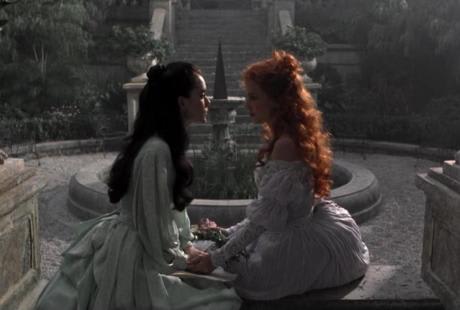In part inspired by Bram Stoker's novel, and embellished with ideas from other incarnations of Dracula throughout the history of cinema, Francis Ford Coppola's wildly baroque and exceedingly pretentious and stylized ode to the undead is nothing if not an experience. The overt subtext and over-the-top performances—with actors flailing around sets and yelling their inflated, grandiloquent dialogue—demand attention and reaction, whether positive or negative.
And still, save the green sex fog, the complex art direction and gothic set designs give the text a timeless, visual component that still holds up, making the love story between the overly chaste Mina (Winona Ryder) and Dracula (Gary Oldman)—basically Vlad the Impaler forced into eternal life for defying God—far more palpable and passionate than anything involving sparkly vampires.
Coppola's interpretation of the text partially acknowledged the role of Victoria women apparent in the novel, also borrowing the epistolary framing device when acknowledging communications between Transylvania and England, but dove further into the sexual component. Once Mina's fiancé, Jonathan Harker (Keanu Reeves) winds up captive in Dracula's castle, ostensibly made a sex slave and food tray for three topless vampires, the narrative shifts to sexual admonitory, wherein virginal young women are punished—with a syphilis allegory, no less—for indulging in repressed passions.
Initially, Dracula's travels to England to eat, or fuck, Mina, whose resemblance is uncannily like that of his long-dead true love, leads to him biting into some low hanging fruit—Mina's slutty best friend Lucy (Sadie Frost). The resulting blood infection raises the eyebrows of Val Helsing (Anthony Hopkins), a lecturer and vampire hunter, which leads to an abundance of graphic matches, melodramatic scoring and intense shouting matches and chase scenes when young women aren't clutching at the bosoms and writhing in orgasm covered in blood.
The sex and death shtick is obvious, as is the male perspective on nascent female sexuality as monstrous, but the intense stylizations of the material and heavily grandiose tone, which is consistent throughout, gives it all a memorable, passionate slant that keeps it short of misogyny. Even the idea of vilifying Mina and Lucy for acknowledging and, in part, taking ownership of their desires—regardless of the resulting, contrary moral message—is an intriguing spin on the politics of 19th Century gender performance. It makes Mina's eventual acquiescence to her fate with the safe and exceptionally bland Jonathan (whose similar dalliance with vampires is shrugged off) a tragic ending.
If anything, Coppola's bold melodrama is an example of pretense done well; not holding back for fear of criticism and being too far gone to have any sort of self-awareness or apology for its own sensational posturing.
Dracula screens at the TIFF Bell Lightbox as part of the Whoa: The Films of Keanu Reeves retrospective at 9pm on March 1st, 2013.
(Sony)And still, save the green sex fog, the complex art direction and gothic set designs give the text a timeless, visual component that still holds up, making the love story between the overly chaste Mina (Winona Ryder) and Dracula (Gary Oldman)—basically Vlad the Impaler forced into eternal life for defying God—far more palpable and passionate than anything involving sparkly vampires.
Coppola's interpretation of the text partially acknowledged the role of Victoria women apparent in the novel, also borrowing the epistolary framing device when acknowledging communications between Transylvania and England, but dove further into the sexual component. Once Mina's fiancé, Jonathan Harker (Keanu Reeves) winds up captive in Dracula's castle, ostensibly made a sex slave and food tray for three topless vampires, the narrative shifts to sexual admonitory, wherein virginal young women are punished—with a syphilis allegory, no less—for indulging in repressed passions.
Initially, Dracula's travels to England to eat, or fuck, Mina, whose resemblance is uncannily like that of his long-dead true love, leads to him biting into some low hanging fruit—Mina's slutty best friend Lucy (Sadie Frost). The resulting blood infection raises the eyebrows of Val Helsing (Anthony Hopkins), a lecturer and vampire hunter, which leads to an abundance of graphic matches, melodramatic scoring and intense shouting matches and chase scenes when young women aren't clutching at the bosoms and writhing in orgasm covered in blood.
The sex and death shtick is obvious, as is the male perspective on nascent female sexuality as monstrous, but the intense stylizations of the material and heavily grandiose tone, which is consistent throughout, gives it all a memorable, passionate slant that keeps it short of misogyny. Even the idea of vilifying Mina and Lucy for acknowledging and, in part, taking ownership of their desires—regardless of the resulting, contrary moral message—is an intriguing spin on the politics of 19th Century gender performance. It makes Mina's eventual acquiescence to her fate with the safe and exceptionally bland Jonathan (whose similar dalliance with vampires is shrugged off) a tragic ending.
If anything, Coppola's bold melodrama is an example of pretense done well; not holding back for fear of criticism and being too far gone to have any sort of self-awareness or apology for its own sensational posturing.
Dracula screens at the TIFF Bell Lightbox as part of the Whoa: The Films of Keanu Reeves retrospective at 9pm on March 1st, 2013.
